After chasing the sun as it sets at Maravillosa Park on our first-day trip in Marvilla, Tabuelan, Cebu comes the next day where I chase the sun again but this time it's how it rises. Let me share with you the second part of my Maravillosa Park adventure and how I discovered some unusual sightings that made Maravillosa Beach Park one story to tell and this story is a validation of Rachel Carson's statement that:
"In every curving beach, in every grain of sand, there is a story of the Earth."
And here is my fair share of the story of the Earth that will begin in 5, 4, 3, 2, 1,...............................read on!

Unseen Mr. Sun / Photo Credit: Dimpsy via Facebook
It was past 5 am the next morning when I had an early walk at the middle of the sea on a very low tide and trying to chase the rising sun but unfortunately, the sun hid at the other side of the district where viewing is of lesser chances. From where I stood taking this photo I waited for more minutes for the sun to come out but then again Mr. Sun is nowhere to be found and the photo above is the only one I got of the sunrise.
I enjoyed walking on the muddy white sand barefooting. It gives a certain relief for myself after a sleepless night because of some rowdy unconcerned guests but who's to blame it's a beach anyway. As I walk on the muddy white sand I found a lot of underwater creatures that are literally alive and kicking and some sand formations that kept me wondering how it was possible. Read on as I narrate the story on unveiling the wonders of the sea in Maravillosa Beach Park.
Early Walk / Video Credit: Yen Yoh via Youtube
I have a recorded video here during my early walk to chase the sun as it rises in Maravillosa beach. It will show you the white sand on a low tide level, some stones wrapped in green algae, starfish, the hidden sun and a 360% view of the beach.
WHAT CAN YOU SEE DURING A LOW TIDE?
What I normally see during low tide is mostly rockweeds, algae either green or brown, rocks - big or small, the sandbar and even rubbish for some public beaches. But for this trip, I found different first-hand sightings that left myself in awe and wonder. So here is the list of wonders that I discovered during the low tide level of Maravillosa beach. I named each species and formations on how I first saw them.
► SNAIL CRAWLER
-
Scientific Name and Origin of Species
- Lobatus gigas is the scientific name of a Conch snail but very commonly it is called the Queen Conch and originally known as the Strombus gigas that belongs to the family of Strombidae or the true conchs. These species are natives to North and Central America with sightings from North Carolina to the Florida Keys as well as in the Caribbean Sea and the Bahamas Islands.
-
Specie Description
- It is a traditional sea snail shape which is in a cylinder or cone shape form having an elongated part of their boot. The color of their shell changes depending on its maturity.
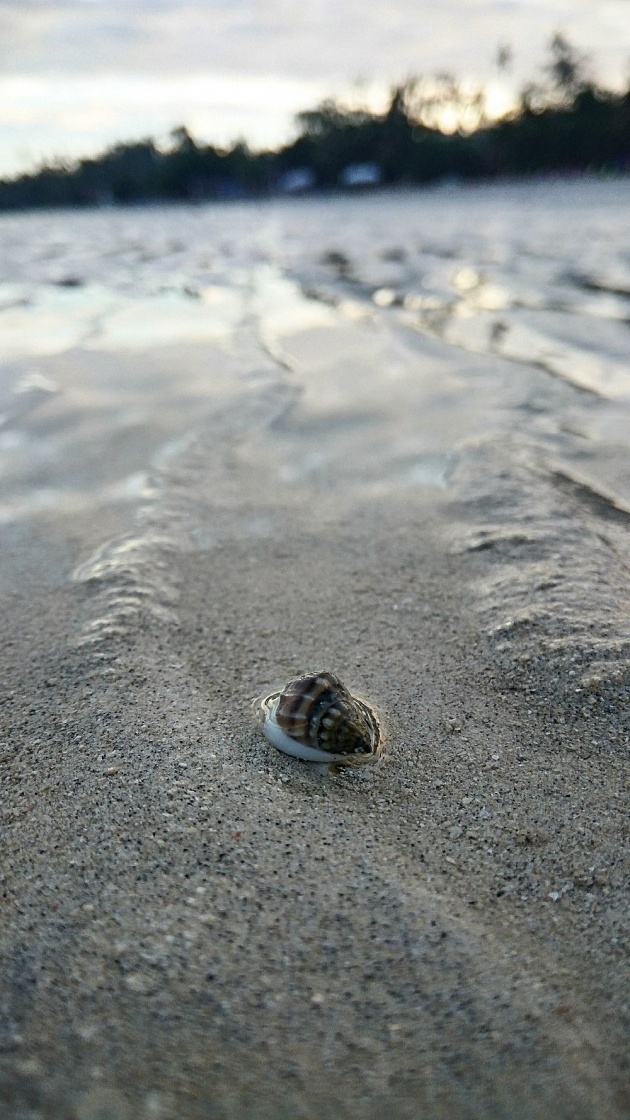
Snail Crawler / Photo Credit: Dimpsy via Facebook
There is a lot of tiny conches that are struggling to dig down the ground as they swayed by the current of the water. I saw one and had it captured while in motion. The one in the photo is the biggest snail that I've seen on that day and had a different color than the rest. He was trying to dig into the ground and suddenly tucked himself in the shell as soon as he senses that someone is approaching but when you try to take a closer look at the photo just below his boot you can see a portion of his slimy body that sneaked out a bit. He was actually trying to move as you can see the rippled water around his shell but refrain from doing so after sensing a life threatening movement in his surrounding.
► LOCKED-UP STARFISHES
-
Scientific Name and Origin of Species
- This type of species is what you call the sand sifting starfish or the comb sea star that came from the family of Astropectinidae. The scientific name of this kind of starfish is Astropecten Polyacanthus that originates in the Eastern Pacific Ocean including Fiji and Tonga. Astropecten (first name) is the generic name of the starfish that is most widely spread in Indo-Pacific region and Polyacanthus is the specific name of a species that comes from the Latin word that means "many thorned".
-
Specie Description
- A lateral arrangement of spine-like structure or teeth distributed along the outer edges of its five arms is what you can see in the photo below. They use those spines in performing sand-related activities like burrowing, locomotion, and for food searching.
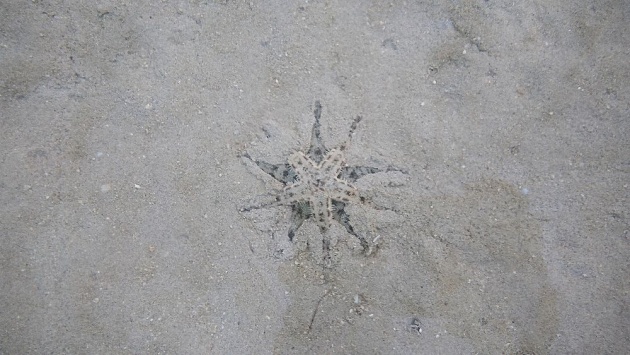
Starfishes Photo Credit: Dimpsy via Facebook
Starfishes are the common sightings when you are on the beach. But what is uncommon to me is to see starfishes locked up together. The bottom starfish is bigger than the one on top. They also have different colors of gray, black, and brown as what they call paxillae.
► BLUE CRABLET DIGGER
-
Scientific Name and Origin of Species
- An endangered species that has a scientific name of Callinectes sapidus that comes from the Greek word "calli" which means beautiful and "nectes" means swimmer while "sapidus" in Latin is savory -- in short this blue crab is "savory beautiful swimmer". These crabs come from the waters of the western Atlantic Ocean and in the Gulf of Mexico before it was introduced internationally. Commonly called as the Blue Crab, Atlantic Blue Crab or the Chesapeake Blue Crab.
-
Specie Description
- Not all blue crabs are in shades of blue but they can also be in red-hues. These species are considered to be land crabs but female crabs lay their eggs in the sea. The sexuality of these crabs can be determined by the shape of their abdomen. Male blue crabs have a long and slender in a "T" form abdomen while the female blue crabs have a wide and rounded abdomen that changes during maturity. During the transition, the abdomen of the female blue crab changes from a triangular form to a circular one as you can see in the photo below.
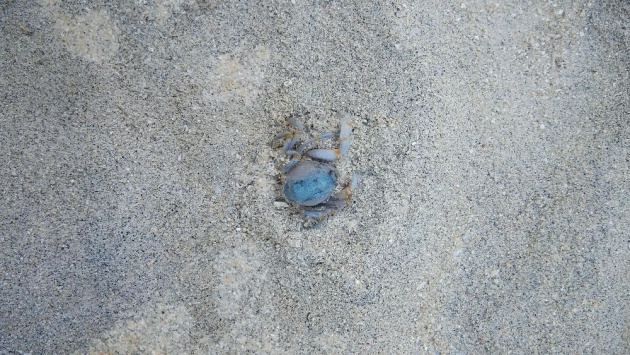
Blue Crab / Photo Credit: Dimpsy via Facebook
No wonder this crab was struggling to reach the seabed to dig while trying to suppress the current of the sea water. After their mating season, the female blue crab will migrate to saltier water to lay their eggs. Now I fully understand why the blue crab in the photo was trying her best to reach her legs to the ground. Imagine, that tiny tummy has millions of blue crab eggs that need to be laid and hatched.
Snail, Starfish, and Blue Crab / Video Credit: Yen Yoh via Youtube
Let me show you a compiled video of the three species that I caught live in action. Among the three species, it's the blue crab that I like most. Not because blue is my favorite color but because on how she manages to deal with the struggles as she was trying to lay her eggs on the sand. It made me realized that every living thing on this planet has its own struggles and it's just a matter of how you deal with it.
► ROCKY SANDS
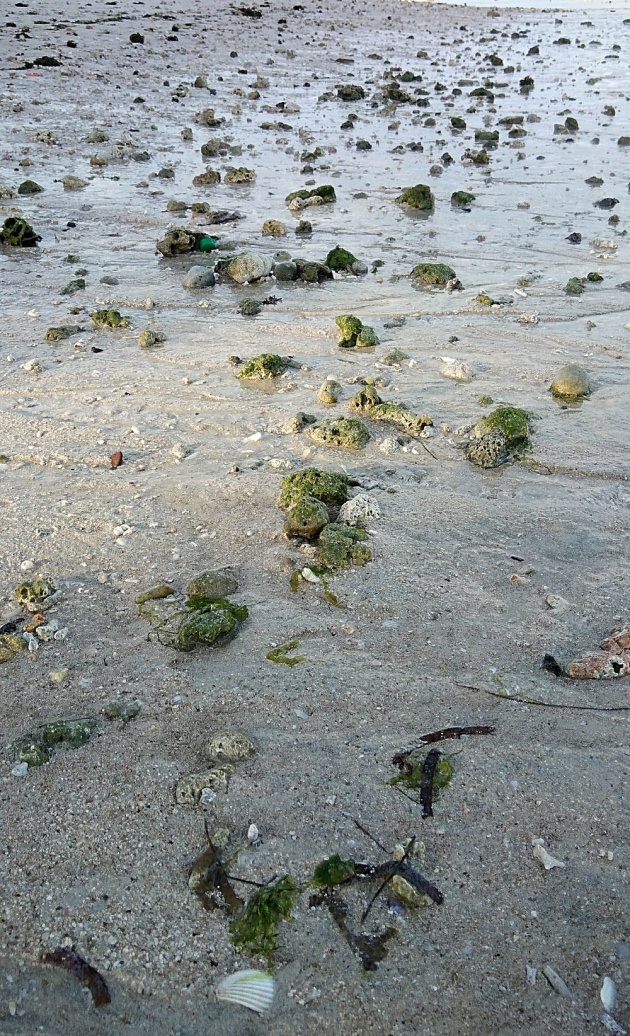
Algae on the Rocks / Photo Credit: Dimpsy via Facebook
I was expecting that I will be walking all the way on the sand but unexpectedly there's a part of the sea (not too far from the shore) where stones and little rocks were spreading. The stones and rocks were mostly wrapped by seaweeds and green algae. Algae is a type of organism that grows on rocks and often exposed during low tide. Primarily they are aquatic and manufactures their own foods. Green Algae contain two forms of chlorophyll that capture light energy that fuels the manufacture of sugar.
► MINI SAND DUNES
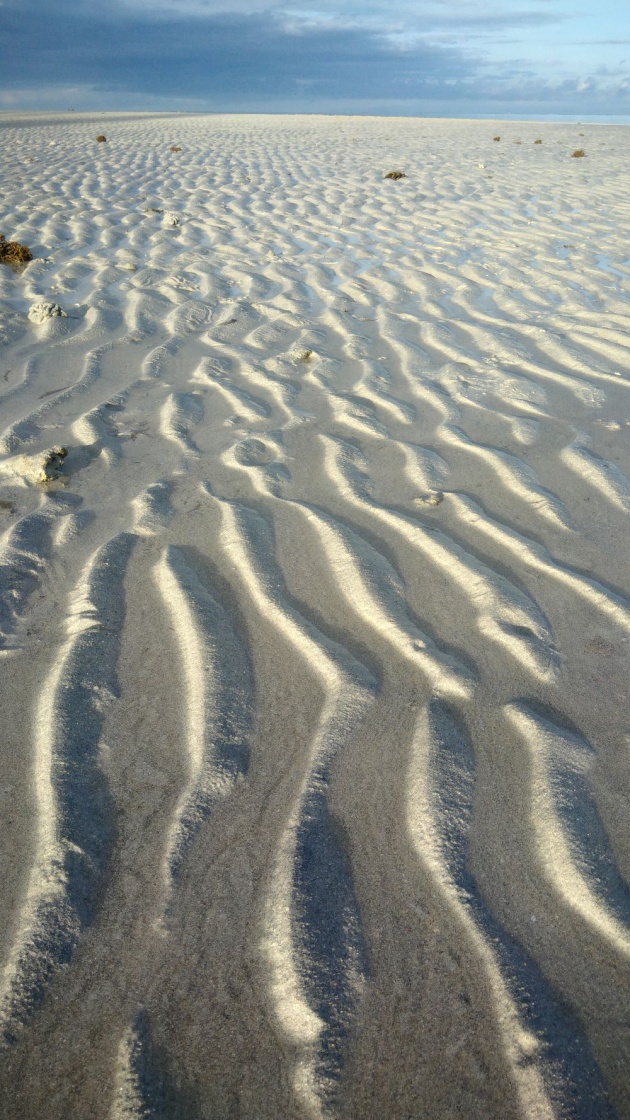
White Sand Dunes / Photo Credit: Dimpsy via Facebook
After the rocky seabed walk, I came to the duned white sands that spread widely to the sea as far as my eyes can see. Sand dunes are not limited to desserts only but in coastal areas as well. As per physical geography's definition of a dune, "it is a hill of loose sand built by aeolian processes (wind) or by the flow of water".
What is an Aeolian Processes?
Aeolian Processes as per the study of geology and weather this process pertains to the activity of the wind specifically its ability to shape the Earth's surface and the rest of the planets.
Source: Wikipedia
Wind blowing off a sand's surface will create ripples that indicate a brisk stirring of either water, current, waves, or wind that forms different kinds of shapes. There are four types of ripples and the one in the photo is the what we call the Sinuous ripples that are represented by a curve pattern going up and down due to the unidirectional flow of current. The other three types of ripples are Straight Ripples, Catenary Ripples, Linguoid Ripples.
► SAND FORMATIONS
-
SAND POOP
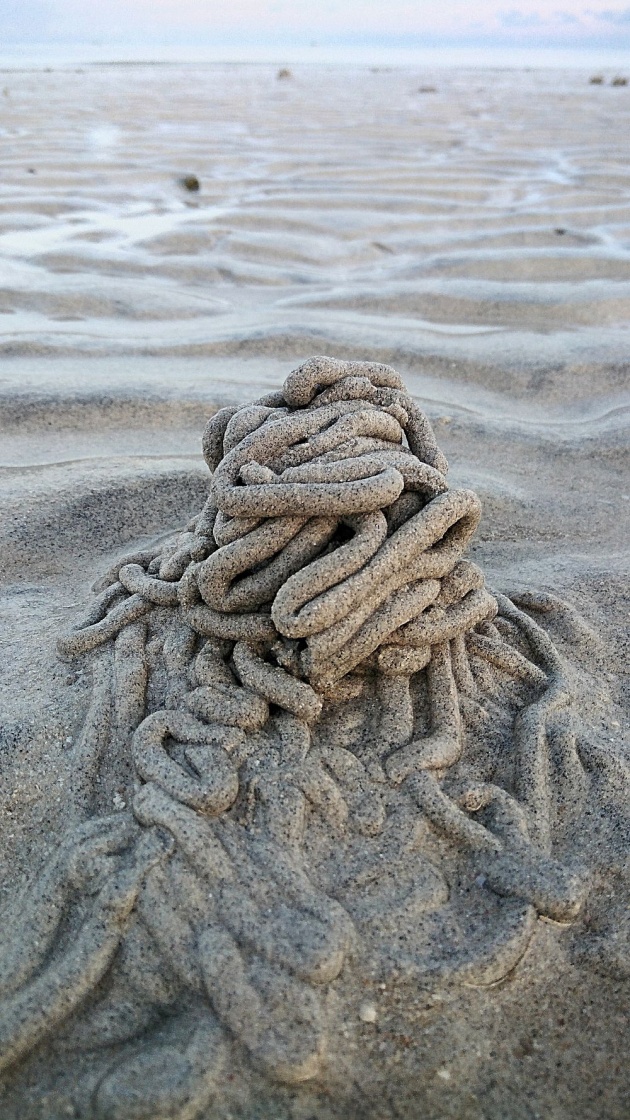
Sand Poop / Photo Credit: Dimpsy via Facebook
What came to my mind upon seeing this sand formation was a poop. I call this one as a sand poop then questions popped into my head "how is this possible"? Do fishes pooped sands? Well, I've read an article that giant bumphead parrotfishes excrete white sands. Parrotfish eat algae that stick on the rocks and dead corals that are made of calcium carbonate. Gnawing the algae, the calcium carbonate, and grind it up and blow it out in hundred pounds of sands. No wonder it heaped up like this. LOL
-
VOLCANO CRATER
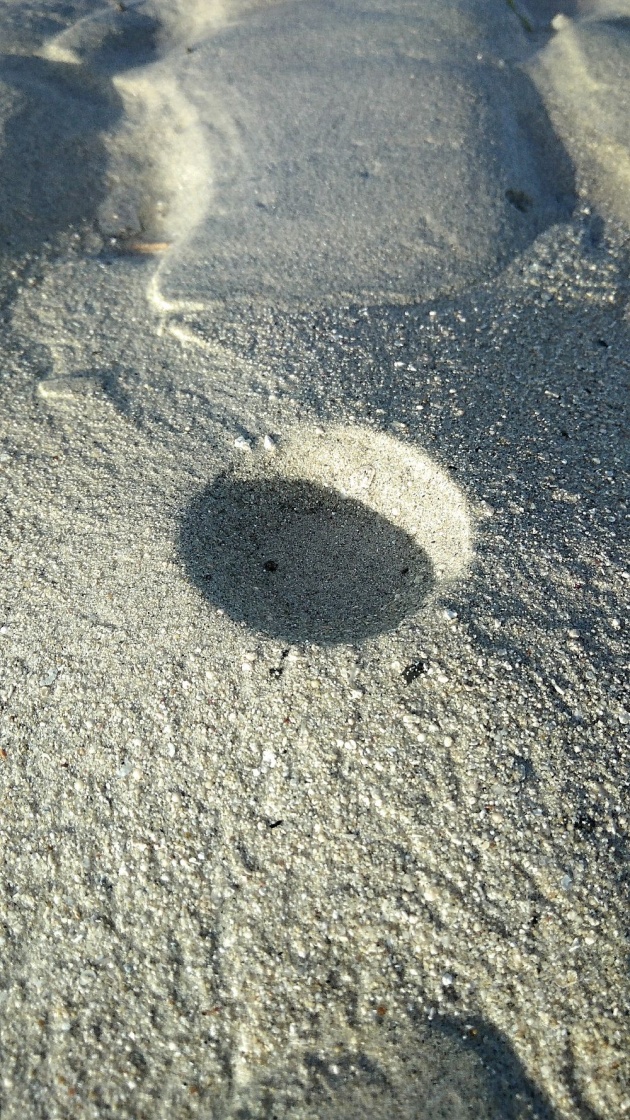
Volcano Crater / Photo Credit: Dimpsy via Facebook
How I see it on the sand is a volcano crater or a pit. The pit is perfectly in shape and this is due to the heavy mineral layer. The formation of this sand starts from as a domed sand which is called a blister. When the mineral layer is shortened by erosion a nail hole is produced and when the blister is removed by the splash of water it creates a circular depression or pit.
-
UNIDENTIFIED CURLING OBJECT
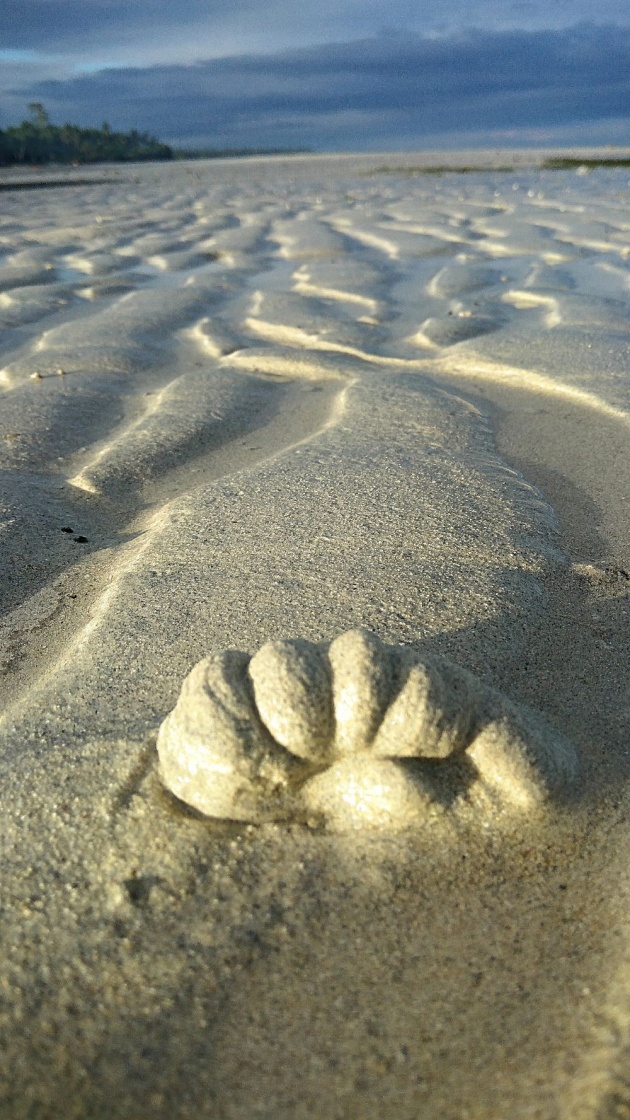
Unidentified Curling Object / Photo Credit: Dimpsy via Facebook
I thought of this photo at first as a croissant bread form when I saw and took a snap on it. It took me some time to stare at this formation while wondering how this form was even possible before pressing the snap button. Until two weeks ago when I zoomed in the photo I discovered that it has facial parts like the eyes, nose, and a mouth. Now I see it as a curled up lobster with the head of an ET. LOL! Good thing I never saw these features on hand because if I did I definitely turn my back on and abandoned the area. It's a bit strange for me but I felt like the underwater world is trying to unveil its wonders during the low tide level for me to witness its wondrousness and let it be a story to tell in Maravillosa beach park.
► THE SANDBAR
-
WHAT IS A SANDBAR?
- According to the worldlandforms.com, a Sandbar is "an area of sand, gravel or fine sediment that sits above the water".
-
CHARACTERISTICS OF SANDBAR
- There are 3 main characteristics of sandbar landforms and these are the following:
- It is made out of sand, gravel, or silt.
- The forms are brought about by the action of the waves and currents.
- And sandbars usually straight and narrow but the one in Pandanon Island is a winding one as I stated it in my previous summer travel blog Pandanon Island - Last Minute Summer Getaway
- There are 3 main characteristics of sandbar landforms and these are the following:
-
FORMATION OF SANDBARS
- In the beginning, sandbars are formed underwater that is built by swirling turbulence of the waves from the offshore of a beach through a bunk in the sandy bottom. These sands are being carried over to the beach and some are deposited into the offshore side of the bunk where every receding wave and rip flow the sand will add up to the bar.

On the Sandbar / Photo Credit: Dimpsy via Facebook
One of the best features that a beach or an island can have is the Sandbar. Not all beaches and islands have sandbars. Fortunate for us we were able to enjoy the sandbar in Maravillosa beach before sunset on our first day and after sunrise on our second day on the beach. An added attraction would be the appearance of the sun in either way it rises or it sets but it would be awesome if both way it occurs.
Share with me how often do you travel by using this Querlo chat.
END OF STORY
My wonderous low tide adventure ended at the sandbar. It was a fulfilling morning walk aside from discovering it on my own. There are things that you can't really explain how it is happening and all you just need is to try to understand the message it conveys and how you interpret it in a way that both worlds are beneficial. What I witnessed on that day in Marvillosa beach park is one great story that I need to tell. A realization was made after seeing the struggles of the blue crab on trying to lay her eggs on the ground despite the sea current and the possible life-threatening events that she might encounter from the hands of other beings on the land. You see, nature has its own way of unveiling its wonders in Maravillosa beach park and the best thing that I can do is to write a blog and tell every reader about that one story in Maravillosa beach park.
Thank you for reading my blog and I hope you get to enjoy the best of nature just as I enjoyed it most. Until my next blog.
You can visit my page for more travel blog posts. Feel free to click on this link.
♥ ♥ ♥
Other travel blogs to read:
Chasing the Sun at Maravillosa Park
Pandanon Island - Last Minute Summer Getaway
Macau Tower: The World's Highest Bungy Jump
The Venetian Macao: A Journey to Venice Italy
HOTEL-CASINO HOPPING IN MACAU
A Side Trip: Getting Around in Macau
Ocean Park Hong Kong - One of a Kind Marine Life Adventure
Please visit my page Dimpsy to read more travel blogs. Thank you.



